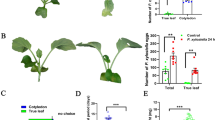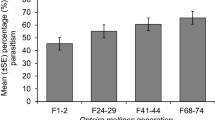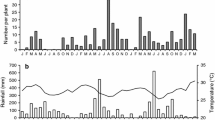The host plant expansion of a diamondback moth, Plutella xylostella (L.) (DBM) strain to snowpea (Pisum sativum L.) raised the question whether a specialist parasitoid Diadegma semiclausum (DS) could be conditioned to locate and parasitize its host on the new host plant. In a specialist parasitoid a behavioural change towards a plant outside the normal host plant range of its host due to developmental experience is not expected. The responsive behaviour, parasitism rates and fitness of three subsequent DS generations were investigated on the snowpea-strain of DBM. After three generations of DS on the pea 62.5% of females chose an DBM-infested pea plant over DBM infested cabbage. Only 16.4% of cabbage-reared DS was attracted to infested pea. Rearing of the parasitoid in host larvae on peas significantly increased the number of larvae parasitized on this host plant in the first generation; however, there was no further increase in generations 2 and 3. Larval mortality was similar for all parasitoid/DBM combinations on both host plants, but significantly higher mortality occurred in parasitoid pupae from peas. Development time of the parasitoid was slightly prolonged on the pea strain of DBM. The number of females produced by parasitoids reared on the pea strain of DBM was significantly reduced as compared to D. semiclausum reared on the cabbage strain on both host strains. Results show that DS has the potential to change its responsive behaviour in order to locate its host on a new host plant. According to the current view, a specialist parasitoid is not expected to change its reaction to a plant outside the normal host plant range of its host. Within 3 generations, responsive behaviour towards snowpea could be increased. However, fitness trade-offs, especially an extreme shift in sex ratio to males reduced reproductive success.


Similar content being viewed by others
REFERENCES
Abbas, M. S. T. (1988). Biological and ecological studies on Diadegma semiclausum Hellen (Hym., Ichneumonidae), a larval parasite of the diamondback moth, Plutella xylostella (L.) (Lep., Plutellidae) in Egypt. Anz. Schaedlingskde, Pflanzenschutz, Umweltschutz 61: 1–2.
Barbosa, P., Saunders, J. A., Kemper, J., Trumbule, R., Olechno, J., and Martinat, P. (1986). Plant allelochemicals and insect parasitoids. Effects of nicotine on Cotesia congregata (Say) (Hymenoptera: Braconidae) and Hyposoter annulipes (Cresson) (Hymenoptera: Ichneumonidae). J. Chem. Ecol. 12: 1319–1328.
Barron, A. B. (2001). The life and death of Hopkins' host-selection principle. J. Ins. Behav. 14: 725–737.
Benrey, B., Denno, R. F., Kaiser, L. (1997). The influence of plant species on attraction and host acceptance in Cotesia glomerata (Hymenoptera: Braconidae). J. Ins. Behav. 10: 619–630.
Billquist, A., and Ekbom, B. (2001). Effects of host plant species on the interaction between the parasitic wasp Diospilus capito and pollen beetles (Meligethes spp.). Agricult. Forest Entomol. 3: 147–152.
Bjorksten, T. A., and Hoffmann, A. A. (1995). Effects of pre-adult and adult experience on host acceptance in choice and non-choice tests in two strains of Trichogramma. Ent. Exp. Appl. 76: 49–58.
Bogahawatte, C. N. L., and Van Emden, H. F. (1996). The influence of the host plant of diamondback moth (Plutella xylostella) on the plant preferences of its parasitoid Cotesia plutellae in Sri Lanka. Physiol. Entomol. 21: 93–96.
Campan, E., and Benrey, B. (2004). Behavior and performance of a specialist and a generalist parasitoid of bruchids on wild and cultivated beans. Biol. Contr. 30: 220–228.
Campos, F., Domskov, N., Arnason, J. T., Philogène, B., Atkinson, J., Morand, P., and Werstiuk, N. H. (1990). Biological effects and toxicokinetics of DIMBOA in Diadegma terebrans (Hymenoptera: Ichneumonidae), an endoparasitoid of Ostrinia nubilalis (Lepidoptera: Pyralidae). J. Econ. Ent. 83: 356–360.
Charnov, E. L., Los-den Hartogh, R. L., Jones, W. T., and Van Den Assen, J. (1981). Sex ratio evolution in a variable environment. Nature 289: 27–33.
Cortesero, A. M., Stapel, J. O., and Lewis, W. J. (2000). Understanding and manipulating plant attributes to enhance biological control. Biol. Contr. 17: 35–49.
Cronin, J. T., and Abrahamson, W. G. (2001). Do parasitoids diversify in response to host-plant shifts by herbivorous insects? Ecol. Entomol. 26: 347–355.
Fox, L. R., Kester, K. M., and Eisenbach, J. (1996). Direct and indirect responses of parasitoids to plants: sex ratio, plant quality and herbivore diet breadth. Ent. Exp. Appl. 80: 289–292.
Gandolfi, M., Mattiacci, L., and Dorn, S. (2003). Preimaginal learning determines adult response to chemical stimuli in a parasitic wasp. Proc. R. Soc. Lond. B, Biol. Sci. 270: 2623–2629.
Geervliet, J. B. F., Vet, L. E. M., and Dicke, M. (1996). Innate responses of the parasitoids Cotesia glomerata and C. rubecula (Hymenoptera: Braconidae) to volatiles from different plant-herbivore complexes. J. Ins. Behav. 9: 525–538.
Godfray, H. C. J. (1994). Parasitoids. Behavioral and evolutionary ecology. Monographs in Behavior and Ecology. Princton Univ. Press, pp. 1–473.
Harvey, J. A., Jervis, M. A., Gols, G. J. Z., Jiang, N., and Vet, L. E. M. (1999). Development of the parasitoid, Cotesia rubecula (Hymenoptera: Braconidae) in Pieris rapae and P. brassicae (Lepidoptera: Pyralidae): evidence for host regulation. J. Insect Physiol. 45: 173–182.
Hérard, F., Keller, M. A., Lewis, W. J., and Tumlinson, J. H. (1988). Beneficial arthropod behavior mediated by airborne semiochemicals IV.—Influence of host diet on host-oriented flight chamber responses of Microplitis demolitor Wilkinson. J. Chem. Ecol. 14: 1597–1606.
Liu, S., and Jiang, L. (2003). Differential parasitism of Plutella xylostella (Lepidoptera: Plutellidae) larvae by the parasitoid Cotesia plutellae (Hymenoptera: Braconidae) on two host plants. Bull. Entomol. Res. 93: 65–72.
Löhr, B. (2001). Diamondback moth on peas, really. Biocontrol News and Information 19: 38N–39N.
Löhr, B., and Gathu, R. (2003). Evidence of adaptation of diamondback moth, Plutella xylostella (L.), to pea, Pisum sativum L. Insect Sci. Applic. 22: 161–173.
Mackauer, M, Sequeira, R., and Otto, M. (1997). Growth and development in parasitoid wasps: Adaptation to variable host resources. Ecol. Studies 130: 191–203.
Monge, J. P., and Cortesero, A. M. (1996). Tritrophic interactions among larval parasitoids, bruchids, and Leguminosae seeds; influence of pre- and post-emergence learning on parastoids' response to host and host-plant cues. Ent. exp. appl. 80: 293–296.
Ohara, Y., Akio, T., and Takabayashi, J. (2003). Response to host-infested plants in females of Diadegma semiclausum Hellen (Hymenoptera: Ichneumonidae). Appl. Entomol. Zool. 38: 157–162.
Rossbach, A., Löhr, B., and Vidal, S. (2006). Host shift to peas in the diamondback moth Plutella xylostella L. and response of its parasitoid Diadegma mollipla. Bull. Ent. Res. in press
Rossbach, A., Löhr, B., and Vidal, S. (2005). Generalism versus specialism: Responses of Diadegma mollipla (Holmgren) and Diadegma semiclausum (Hellen), to the host shift of the diamondback moth (Plutella xylostella L.) to peas. J. Ins. Behav. 18: 491–503.
Roth, S., Knorr, C., and Lindroth, R. L. (1997). Dietary phenolics affects performance of the gypsy moth (Lepidoptera: Lymantriidae) and its parasitoid Cotesia melanoscela (Hymenoptera: Braconidae). Environ. Ent. 26: 668–671.
Steidle, J. L. M., and van Loon, J. J. A. (2003). Dietary specialization and infochemical use in carnivorous arthropods: testing a concept. Entomol. Exp. Appl. 108: 133–148.
Steidle, J. L. M., Stepphun, A., and Ruther, J. (2003). Specific foraging kairomones used by a generalist parasitoid. J. Chem. Ecol. 29: 131–143.
Talekar, N. S., and Shelton, A. M. (1993). Biology, ecology, and management of the diamondback moth. Annu. Rev. Entomol. 38: 275–301.
Turlings, T. C. J., Wäckers, F. L., Vet, L. E. M., Lewis, W. J., and Tumlinson, J. H. (1993). Learning of host-finding cues by hymenopterous parasitoids. In Papaj, D. R. and Lewis, A. C. (eds.), Insect learning. Chapman and Hall, NY, pp. 51–78.
Vet, L. E. M., and Dicke, M. (1992). Ecology of infochemical use by natural enemies in a tritrophic context. Annu. Rev. Entomol. 37: 141–172.
Vet, L. E. M., and Groenewold, A. W. (1990). Semiochemicals and learning in parasitoids. J. Chem. Ecol. 16: 3119–3135.
ACKNOWLEDGMENTS
The study was conducted within the ICIPE-led project “entitled Biocontrol of Diamondback Moth in East Africa,” financed by the German Federal Ministry of Economic Cooperation and Development (BMZ). The first author and the research were funded by the German Research Foundation (DFG). We further thank J. Steidle for his very helpful comments regarding an earlier version of this manuscript.
Author information
Authors and Affiliations
Corresponding author
Rights and permissions
About this article
Cite this article
Roßbach, A., Löhr, B. & Vidal, S. Does a Specialist Parasitoid Adapt to its Host on a New Host Plant?. J Insect Behav 19, 479–495 (2006). https://doi.org/10.1007/s10905-006-9040-5
Published:
Issue Date:
DOI: https://doi.org/10.1007/s10905-006-9040-5




